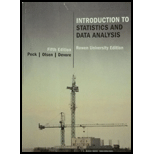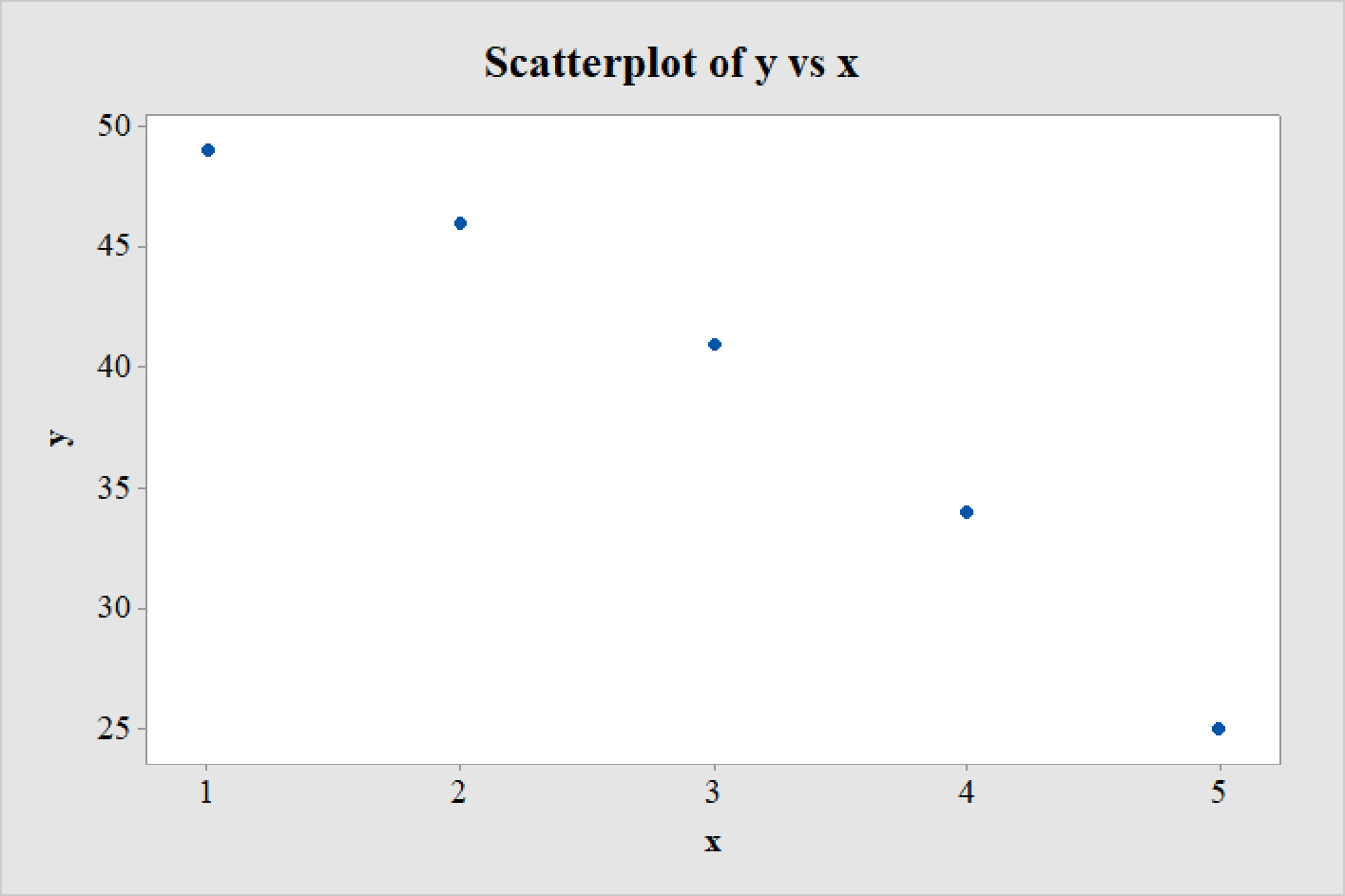
Concept explainers
The accompanying data represent x = Amount of catalyst added to accelerate a chemical reaction and y = Reaction time:

- a. Calculate the value of the
correlation coefficient , r. Does the value of r suggest a strong linear relationship? - b. Construct a
scatterplot . From the plot, does the word linear provide the most effective description of the relationship between x and y? Explain.
a.
Find the correlation coefficient.
Explain whether the correlation coefficient suggest a strong relation or not.
Answer to Problem 55CR
The correlation coefficient is –0.981.
Explanation of Solution
Calculation:
The given data relates to the amount of catalyst added in a chemical reaction, x and the reaction time, y. The correlation coefficient is denoted by r.
Correlation coefficient:
Software procedure:
Step by step procedure to obtain the correlation coefficient using the MINITAB software:
- Choose Stat > Basic Statistics > Correlation.
- Enter the columns of x, y under Variables.
- Click OK in all dialogue boxes.
Output obtained using MINITAB is given below:

Thus, from the output, the correlation coefficient is –0.981.
Interpretation:
A value of the correlation coefficient, r closer to 1 or –1 suggests a strong correlation coefficient, whereas a value closer to 0 suggests a weak correlation coefficient.
Here, the correlation coefficient is –0.981, which is very close to –1. Evidently, the negative sign suggests a negative relationship between the variables, so that, higher values of x are associated to lower values of y.
Thus, the relationship between x and y is a very strong negative linear relationship.
b.
Draw a scatterplot of the data set.
Explain whether it is appropriate to describe the relationship between x and y as linear.
Answer to Problem 55CR
The scatterplot of the data set is as follows:

Explanation of Solution
Calculation:
Scatterplot:
Software procedure:
Step by step procedure to draw the scatterplot using the MINITAB software:
- Choose Graph > Scatterplot > Simple > OK.
- Enter the column of y under Y-variables.
- Enter the column of x under X-variables.
- Click OK in all dialogue boxes.
Thus, the scatterplot is obtained.
Interpretation:
A careful observation of the scatterplot reveals that the points do not exactly fall on a straight line. Rather, the points appear to form a curve with a wide arc.
Hence, it is not appropriate to describe the relationship between x and y as linear.
The arc of the curve being very wide, none of the points would fall to far away from a line drawn through the plot. As a result, the correlation coefficient in Part a has a very high negative value.
Want to see more full solutions like this?
Chapter 5 Solutions
Introduction to Statistics and Data Analysis
Additional Math Textbook Solutions
Mathematics for the Trades: A Guided Approach (11th Edition) (What's New in Trade Math)
Finite Mathematics for Business, Economics, Life Sciences and Social Sciences
Elementary Algebra For College Students (10th Edition)
Elementary Statistics: Picturing the World (7th Edition)
Calculus: Early Transcendentals (2nd Edition)
Elementary and Intermediate Algebra: Concepts and Applications (7th Edition)
- Let X be a random variable with support SX = {−3, 0.5, 3, −2.5, 3.5}. Part ofits probability mass function (PMF) is given bypX(−3) = 0.15, pX(−2.5) = 0.3, pX(3) = 0.2, pX(3.5) = 0.15.(a) Find pX(0.5).(b) Find the cumulative distribution function (CDF), FX(x), of X.1(c) Sketch the graph of FX(x).arrow_forwardA well-known company predominantly makes flat pack furniture for students. Variability with the automated machinery means the wood components are cut with a standard deviation in length of 0.45 mm. After they are cut the components are measured. If their length is more than 1.2 mm from the required length, the components are rejected. a) Calculate the percentage of components that get rejected. b) In a manufacturing run of 1000 units, how many are expected to be rejected? c) The company wishes to install more accurate equipment in order to reduce the rejection rate by one-half, using the same ±1.2mm rejection criterion. Calculate the maximum acceptable standard deviation of the new process.arrow_forward5. Let X and Y be independent random variables and let the superscripts denote symmetrization (recall Sect. 3.6). Show that (X + Y) X+ys.arrow_forward
- 8. Suppose that the moments of the random variable X are constant, that is, suppose that EX" =c for all n ≥ 1, for some constant c. Find the distribution of X.arrow_forward9. The concentration function of a random variable X is defined as Qx(h) = sup P(x ≤ X ≤x+h), h>0. Show that, if X and Y are independent random variables, then Qx+y (h) min{Qx(h). Qr (h)).arrow_forward10. Prove that, if (t)=1+0(12) as asf->> O is a characteristic function, then p = 1.arrow_forward
- 9. The concentration function of a random variable X is defined as Qx(h) sup P(x ≤x≤x+h), h>0. (b) Is it true that Qx(ah) =aQx (h)?arrow_forward3. Let X1, X2,..., X, be independent, Exp(1)-distributed random variables, and set V₁₁ = max Xk and W₁ = X₁+x+x+ Isk≤narrow_forward7. Consider the function (t)=(1+|t|)e, ER. (a) Prove that is a characteristic function. (b) Prove that the corresponding distribution is absolutely continuous. (c) Prove, departing from itself, that the distribution has finite mean and variance. (d) Prove, without computation, that the mean equals 0. (e) Compute the density.arrow_forward
- 1. Show, by using characteristic, or moment generating functions, that if fx(x) = ½ex, -∞0 < x < ∞, then XY₁ - Y2, where Y₁ and Y2 are independent, exponentially distributed random variables.arrow_forward1. Show, by using characteristic, or moment generating functions, that if 1 fx(x): x) = ½exarrow_forward1990) 02-02 50% mesob berceus +7 What's the probability of getting more than 1 head on 10 flips of a fair coin?arrow_forward
 Glencoe Algebra 1, Student Edition, 9780079039897...AlgebraISBN:9780079039897Author:CarterPublisher:McGraw Hill
Glencoe Algebra 1, Student Edition, 9780079039897...AlgebraISBN:9780079039897Author:CarterPublisher:McGraw Hill Big Ideas Math A Bridge To Success Algebra 1: Stu...AlgebraISBN:9781680331141Author:HOUGHTON MIFFLIN HARCOURTPublisher:Houghton Mifflin HarcourtAlgebra & Trigonometry with Analytic GeometryAlgebraISBN:9781133382119Author:SwokowskiPublisher:Cengage
Big Ideas Math A Bridge To Success Algebra 1: Stu...AlgebraISBN:9781680331141Author:HOUGHTON MIFFLIN HARCOURTPublisher:Houghton Mifflin HarcourtAlgebra & Trigonometry with Analytic GeometryAlgebraISBN:9781133382119Author:SwokowskiPublisher:Cengage
 Functions and Change: A Modeling Approach to Coll...AlgebraISBN:9781337111348Author:Bruce Crauder, Benny Evans, Alan NoellPublisher:Cengage Learning
Functions and Change: A Modeling Approach to Coll...AlgebraISBN:9781337111348Author:Bruce Crauder, Benny Evans, Alan NoellPublisher:Cengage Learning Holt Mcdougal Larson Pre-algebra: Student Edition...AlgebraISBN:9780547587776Author:HOLT MCDOUGALPublisher:HOLT MCDOUGAL
Holt Mcdougal Larson Pre-algebra: Student Edition...AlgebraISBN:9780547587776Author:HOLT MCDOUGALPublisher:HOLT MCDOUGAL





